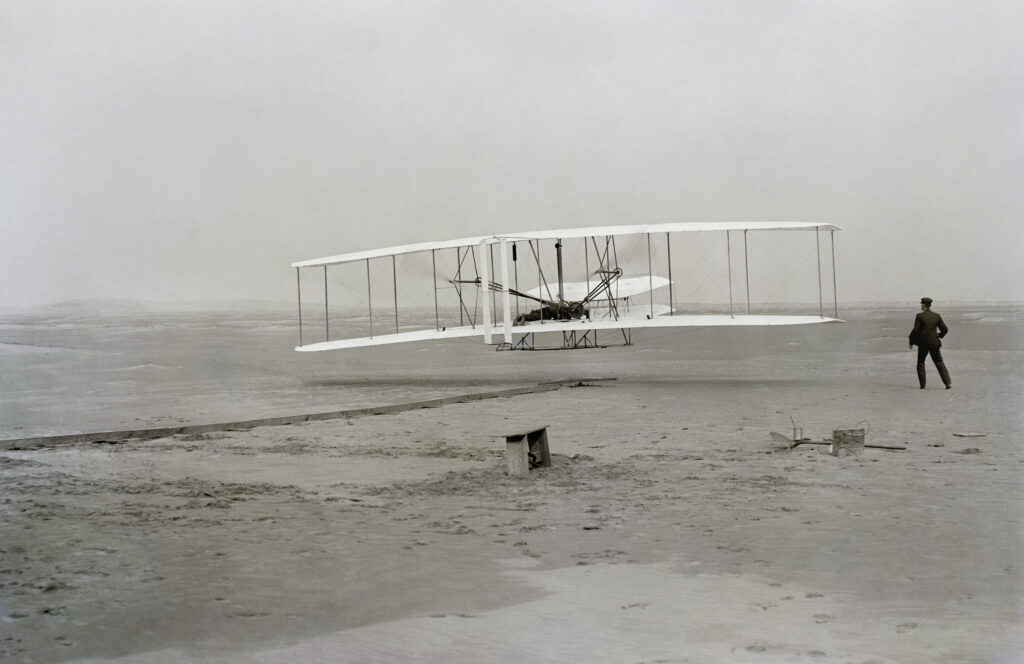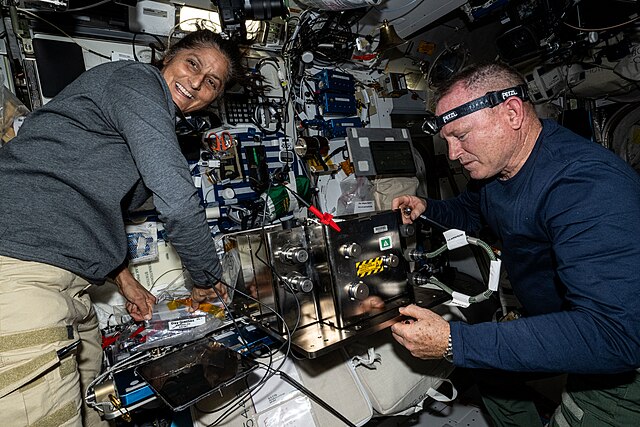by Julius Lacano
Operation JUBILEE: A Tactical Failure
Issues with Operation JUBILEE became evident from the start. Commanders argued about tactics and disagreed about the mission’s aims. They also withheld promised air and naval support, and the two practice landings were fiascoes. Despite a marked lack of military experience and a spotty reputation as a commander, Mountbatten used his charm, charisma, overconfidence, and strong connections to the royal family to calm his fellow planners.
With its total force of over 10,000 front and support forces, JUBILEE was RUTTER without all the support needed to give it even the slightest chance of success. In fact, no bombers were allowed to attack due to the risk of civilian casualties, and no battleships would be provided because the Allies did not have air superiority over the landing beaches. The Canadian Army provided about 6,000 untested troops supported by tanks and other mechanized vehicles, the Royal Navy provided 237 vessels, consisting of eight destroyers, nine landing ships, and hundreds of smaller boats and landing craft, while the Royal Airforce provided 74 squadrons. Attached to the Canadian troops were US Army Rangers and French and British Commandos.
The raid had several goals:
- Gather intelligence on and neutralize beach defenses and fortifications.
- Capture the Pourville radar station on the cliffs overlooking Dieppe.
- Capture the town and port and hold it before retreating.
The only success of the entire operation was the destruction of the six guns that made up the coastal battery Hess. US Army Rangers and British Commandos came ashore and scaled the tall cliffs the battery was built upon, neutralized the German soldiers, and captured the gun emplacement. This action became a model for future Commando operations and was used at Pointe du Hoc during the invasion of Normandy.
The mission to capture the radar station was also partially successful. While unable to breach the defenses and capture the station outright, a RAF radar technician cut the station’s telephone lines under heavy fire. This meant that the Germans had to rely on radios to communicate. British listening posts across the channel picked up and recorded their conversations in real-time and learned a great deal about the capabilities and locations of enemy radar.
The landings of the Canadian troops were a total debacle. Due to a lack of armored support, the troops that landed on the beach were pinned down by heavy defensive fire from machine gun nests dug into the surrounding cliffs. Heavy losses occurred as men unable to overcome the beach’s sea wall became huddled together into kill zones. The hoped-for tanks finally arrived late and provided little support. Two sank immediately into deeper-than-expected water, 12 became stuck in the soft gravel that made up the beach, but 15 managed to make it over the sea wall. These tanks soon encountered anti-tank obstacles and had to retreat to the beach. Around five hours after the landings began, a general retreat was issued, and the last soldiers stepped off the beach at around 2 pm. The Canadians suffered 3,367 killed, wounded, or captured, a casualty rate of around 68%. The Commandos lost 247 men, and the Royal Navy lost one destroyer and 33 landing craft and suffered 550 dead or wounded. Of the 50 Army Rangers that took part, the US lost six men, with a further seven wounded and four captured.
Dieppe was a costly failure that taught the Allies everything they should not do when carrying out an amphibious invasion. Of note was the need for heavy air and naval gunfire support, proper intelligence and surveillance, surprise, and training for beach landings. The dreadful performance of the tanks and landing craft brought on shore also highlighted the need for specialized equipment. The Germans, though, learned an entirely different lesson. Dieppe taught them what was needed to repel a seaborne invasion. In October, the Oberkommando der Wehrmacht, Germany’s military high command, issued orders stressing the importance of fixed coastal defensive batteries and the urgent need to strengthen them and reinforce them with more troops. These orders also imparted the necessity of achieving and maintaining complete air superiority over the landing beaches.
Preparing for D-Day: Operation Overlord
The planners of Operation OVERLORD put significant effort into trying to mitigate each of these issues. Before any invasion could occur, planners needed to know intelligence such as
- The location and makeup of beach fortifications and other positions near the beachhead.
- The location of obstacles and mines placed on the beaches to hamper landing craft and tanks.
- The tides and geography around the landing zones to know the best time to land and the best routes to get off the beach.
- The weather. Since OVERLORD consisted of an airborne and seaborne component (Operation NEPTUNE), planners had to consider how storms or fog could hamper the landings and the ability to drop paratroopers, as well as what part of the moon’s cycle the invasion would take place.
The need to capture an existing harbor was lessened by creating artificial harbors called Mulberries These harbors were prebuilt in England, towed across the Channel, and constructed by US Navy Seabees and British combat engineers. Tanks were adapted with Duplex Drives to make them fully amphibious, while other specialized tanks called “Hobart’s Funnies” were adapted to overcome obstacles on the landing beaches, including minefields, sea walls, and bunkers. The importance of close air support was solved by forming integrated tactical air forces that provided more focused support. This need for support was also aided by ships offshore that could provide targeted attacks on short notice.
Two of Dieppe’s most significant failures were its conception and leadership. Planning for OVERLORD was conducted within a new command structure, Supreme Headquarters Allied Expeditionary Forces, under General Dwight D. Eisenhower, the newly appointed Supreme Commander of the Allied Expeditionary Force. This combined headquarters included staff from Britain, the Commonwealth, the US, and almost every European nation occupied by Germany. No longer were primary military operations planned in a vacuum by those who lacked experience. From then on, promotions were based mainly on merit, not connections. It also helped stem the influence of political pressure on military matters. These last two points were aimed, albeit indirectly, at both Mountbatten and Churchill, the two major proponents of JUBILEE.
Dieppe remains one of the most controversial events in the Second World War, and its meaning is still debated. Though there is little doubt that the failure at Dieppe influenced Allied planners, many feel that these lessons would have been learned without the deaths of thousands. For Canadians, Dieppe maintains its place in the country’s historical memory. The survivors of the raid were left to tend to their mental and physical scars alone and in silence. Instead of being viewed as the victims of a senseless tragedy, their story was entwined with that of victory in the Second World War. The sacrifices they made, the hardships they endured, and the terror they experienced became justified and accepted as a necessary step toward the success of D-Day. Their story was overshadowed, and it was not until 1991 that they were recognized for participation in Operation JUBILLEE.
The Planes of World War II
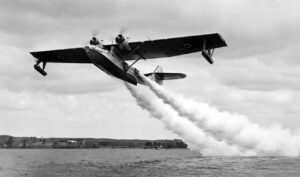
PBY-5A Catalina
Designed as a patrol bomber (thus the PB in its designation), the PBY played a significant role in defeating U-boats in the Atlantic as an anti-submarine and maritime patrol aircraft. With its long-range flying capabilities and being the first U.S. aircraft to be upgraded with airborne radar, Navy Catalina’s became known as “the eyes of the fleet.” A PBY spotted the German battleship Bismarck in 1941 and the Japanese fleet approaching Midway, beginning the battle that would turn the tide of the war in the Pacific. It not only served in the U.S. Navy, but also with the air arms of Britain, Australia, New Zealand, Canada, the Netherlands, and the Soviet Union, and was involved in almost every major operation in World War II.
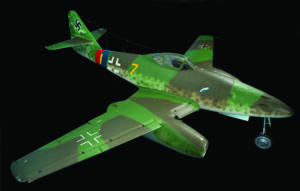
Messerschmitt Me-262A-1 Schwalbe Replica
A weapon that could have turned the tide of World War II, the Me-262 changed air warfare forever. Its top speed was nearly 100 miles per hour faster than the best Allied fighters and it s armaments of four 30mm cannons and 24 unguided rockets was devastating.
Germany flew the world’s first jet in August 1939, and the Me-262 Schwalbe (Swallow) exploited that technology to become the first jet in combat. Pilots were ecstatic with its performance.
The Me-262 dud have drawbacks, including unreliable engines, short range and poor slow-speed performance. But what contributed most to its demise was a lack of fuel. By earl 1945, Allied bombing has destroyed Germany’s ability to produce and transport fuel, leaving many Me-262s grounded.
The Museum’s reproduction was built by Legend Flyers of Everett, Washington, utilizing the same materials and construction techniques as the original Me-262.
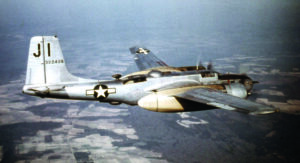
Douglas A-26 Invader
The Douglas A-26 Invader is one of the most versatile combat aircraft ever built, serving in three major wars and a number of minor conflicts in a career that spanned almost three decades.
Designed by legendary engineer Ed Heinemann, the A-26 was capable of fast low-level attack, as well as precision bombing for close support of troops on the ground. Early experience with it in the Pacific was less than encouraging, but modifications were made, and it was reintroduced in Europe during the final months of World War II.
The Museum’s A-26 flew combat with the French Air Force in Indochina before becoming a fire bomber in the 1960s. It was acquired by Evergreen in 1989 and restored over 6,000 hours by Museum volunteers.
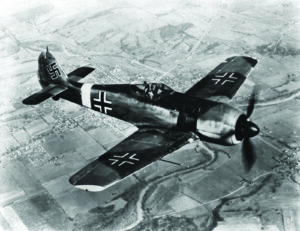
Focke-Wulf Fw-190 Würger
The Focke-Wulf Fw-190 Würger, known for its lethal efficiency and streamlined design, stands as a legendary symbol of German engineering prowess during World War II. Developed in the late 1930s as a response to the need for a versatile, agile fighter aircraft, the Fw-190 quickly became a formidable adversary to Allied forces. Its name, “Würger,” meaning “Shrike” in German, aptly conveyed its predatory nature in the skies.
One of the most striking features of the Fw-190 was its robust airframe and powerful engine, which endowed it with exceptional speed and maneuverability. Armed with a combination of machine guns and cannons, it possessed formidable firepower, making it a fearsome opponent for Allied aircraft. Its innovative design incorporated a wide-track landing gear, which enhanced its stability during takeoff and landing, a crucial advantage for operations on rough airstrips or in adverse weather conditions.
Throughout its operational history, the Fw-190 underwent numerous variants and modifications, demonstrating its adaptability to various combat roles. From its initial role as a fighter interceptor to its later configurations as a ground-attack aircraft and fighter-bomber, the Fw-190 proved its versatility on the battlefield. Pilots lauded its responsive controls and robust construction, which allowed them to execute daring maneuvers with confidence.
Despite its undeniable success, the Fw-190 faced challenges as the war progressed, including the emergence of more advanced Allied aircraft and the strain on Germany’s dwindling resources.
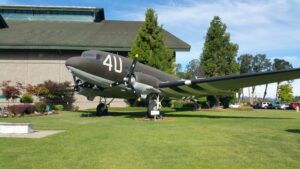
Douglas C-47A Skytrain
Officially called Dakota in England and Skytrain in the United States, soldiers usually referred to C-47s as “Goonie Birds of just “Goonies.” The C-47 is a toughed up version of the successful Douglas DC-3 passenger plane with improved engines, cargo doors, bug enough to admit a jeep, a strengthened rear fuselage and a beefed-up floor to hold loads of equipment. They served in every theater of World War II.
As part of the 89th TCS, the Museum’s C-47A took part in the D-Day Invasion of France on June 6, 1944, flying three missions to drop paratroopers and tow gliders. It later participated in Operation Market Garden in Holland, before returning to the United States, where it eventually served with West Coast Airlines. The Oregon Museum of Science and Industry donated this aircraft to the Museum.
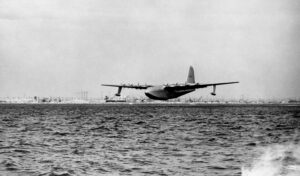
Hughes HK-1 (H-4) Flying Boat Spruce Goose
As the largest airplane ever constructed and flown only one time, the Hughes Flying Boat represents one of man’s greatest attempts to conquer the skies. It was born out of a need to move troops and material across the Atlantic Ocean, where in 1942, German submarines were sinking hundreds of Allied ships. Henry Kaiser, steel magnate and shipbuilder, conceived the idea of the massive flying transport, and turned to Howard Hughes to design and build it. Hughes took on the task, along with the government mandate not to use materials critical to the war effort such as steel and aluminum. Six times bigger than any aircraft of its time, the Flying Boat is made entirely out of wood!
Completed after the end of World War II, the winged giant made only one flight on November 2, 1947. The unannounced decision to fl was made by Hughes during a taxi test. The flight went only a little more than a mile at an altitude of 70 feet for about one minute. But the short hop proved to skeptics that the gigantic machine could fly!

Remembering D-Day Event
To learn about D-Day itself, visit Evergreen Aviation & Space Museum on June 8 for Remembering D-Day: Commemorating the 80th Anniversary. Admission includes a screening of the D-Day film, followed by an engaging panel led by our Education Director and featuring Boeing Senior Historian, WWII Veterans, a C-47 expert, and more. Drop by the Aviator Café for a discounted bite to eat before soaring to new heights with a WWII-focused tour centralized around our C-47 Skytrain that flew in the Battle of Normandy.

